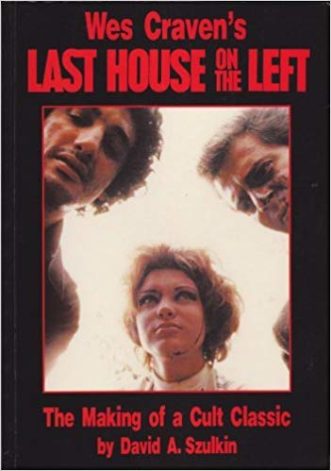 By DAVID A. SZULKIN (FAB Press; 1997)
By DAVID A. SZULKIN (FAB Press; 1997)
A solid, readable account of the making and reception of the original LAST HOUSE ON THE LEFT as told to author David Szulkin. Released back in 1972, it’s one of the seminal horror/exploitation movies. WES CRAVEN’S LAST HOUSE ON THE LEFT is a fairly exhaustive look at all things LAST HOUSE-related, from its inception and production to the many knock-offs that followed in its wake (LAST HOUSE ON DEAD END STREET, LAST HOUSE ON THE BEACH, THE HOUSE BY THE EDGE OF THE PARK, etc).
THE LAST HOUSE ON THE LEFT began with the late Hallmark Pictures and producer Sean Cunningham (of the original FRIDAY THE 13th) and writer/director Wes Craven, who had previously helped craft a successful soft core opus called TOGETHER for the company. Hallmark’s offer was to make a really extreme no-budget horror movie, and Craven responded by writing a script that was apparently far nastier than what ended up onscreen.
Nearly all the participants were interviewed extensively by Szulkin, resulting in an extremely thorough account of the filming of this vile masterpiece, initially called KRUG AND COMPANY. Money was tight but everyone was extremely dedicated, starting with the hard-assed Cunningham and the soft-spoken Craven, who complimented each other nicely. Other notables included musician-turned-actor David Hess as the psychopathic Krug, a role the method-trained Hess took to heart, and actress Jeramie Rain, who really hated the film, now proclaiming it “the worst movie ever made.”
Nearly all the participants were interviewed extensively by Szulkin, resulting in an extremely thorough account of the filming of this vile masterpiece
The finished product, renamed LAST HOUSE ON THE LEFT, caused a huge stir and became a sizeable hit in the process. This was due in no small part to Hallmark’s aggressive advertising campaign, with its legendary tagline “To Avoid Fainting, Keep Repeating, It’s Only A Movie…Only A Movie…Only A Movie…” (The chapter in this book covering the film’s release is appropriately titled “The Launching of A Thousand Lunches”).
Szulkin also relates how the success of LAST HOUSE had the effect of confining Craven and Cunningham to the horror genre for much of the rest of their careers, even though both have tried repeatedly to work in other fields. I’ll bet you didn’t know Cunningham directed two family films in the mid seventies, or that Craven attempted to find financing for several “socially responsible” projects before grudgingly returning to LAST HOUSE territory with THE HILLS HAVE EYES in 1977.
Szulkin also relates how the success of LAST HOUSE had the effect of confining Craven and Cunningham to the horror genre for much of the rest of their careers, even though both have tried repeatedly to work in other fields.
One of the more intriguing aspects of this book—for LAST HOUSE adherents, at least—is its obsessive detailing of the many versions of the film that have appeared on video. There reportedly once existed a 91 minute print, but it’s been pared down considerably over the years. By the time WES CRAVEN’S LAST HOUSE ON THE LEFT was published, the most complete print was via the 84-minute Canadian video version. Since then a new, apparently comprehensive edit was issued on DVD in 2002, which isn’t covered in this 1997 book (of which an updated edition was published in 2000, but I haven’t read it).
